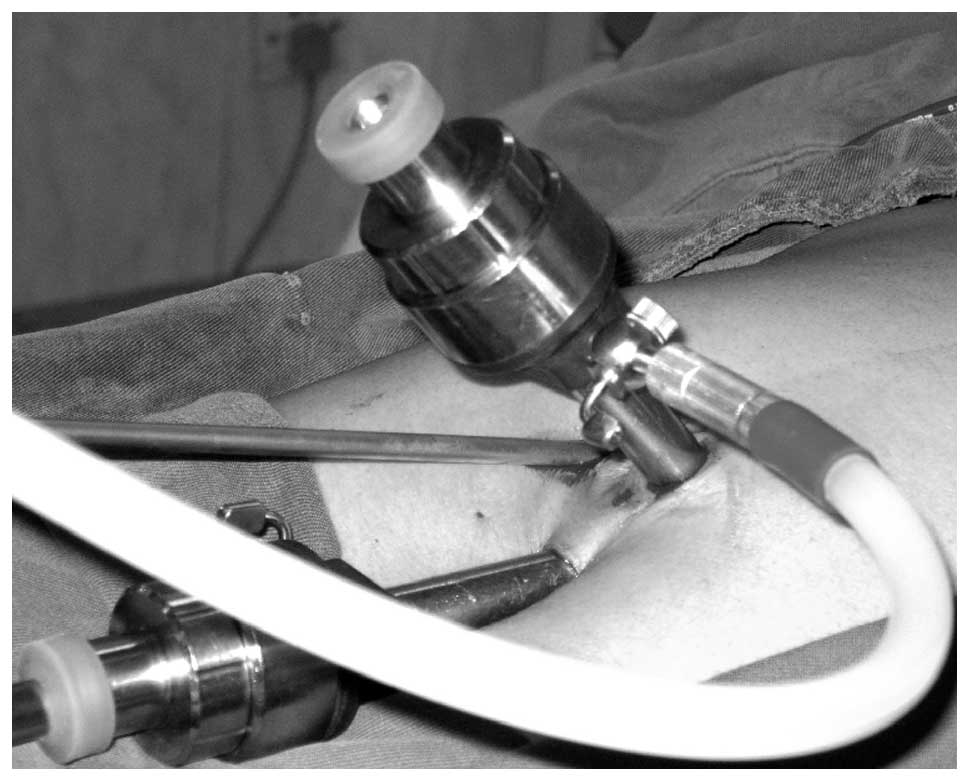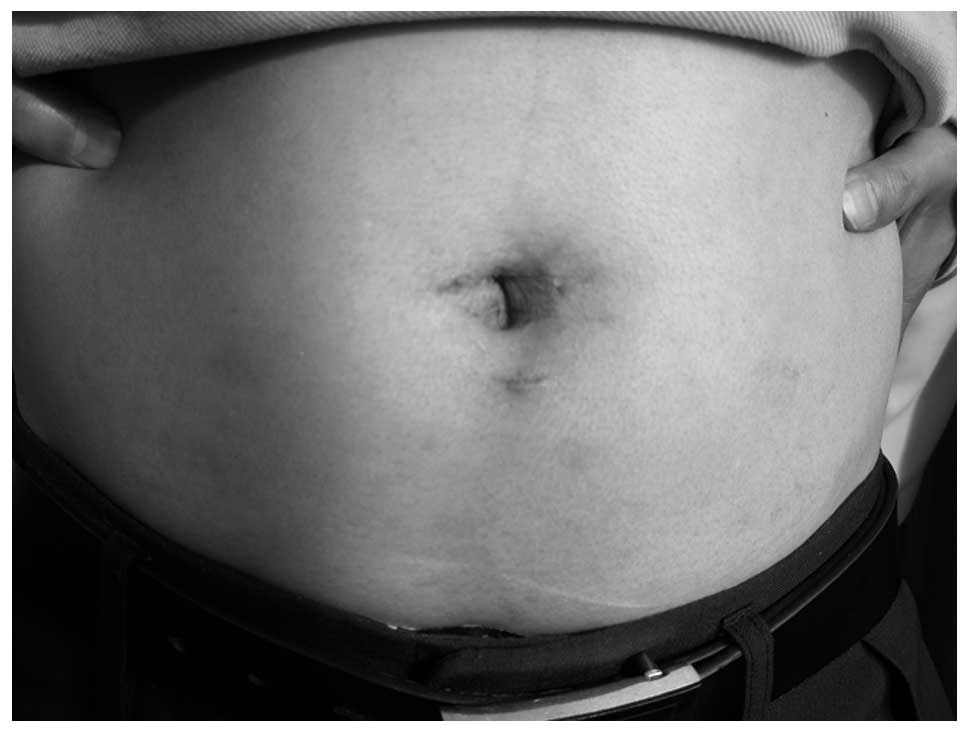|
1
|
Litynski GS: Profiles in laparoscopy:
Mouret, Dubois, and Perissat: the laparoscopic breakthrough in
Europe (1987–1988). JSLS. 3:163–167. 1999.PubMed/NCBI
|
|
2
|
Navarra G, Pozza E, Occhionorelli S,
Carcoforo P and Donini I: One-wound laparoscopic cholecystectomy.
Br J Surg. 84:6951997. View Article : Google Scholar : PubMed/NCBI
|
|
3
|
Marescaux J, Dallemagne B, Perretta S,
Wattiez A, Mutter D and Coumaros D: Surgery without scars: report
of transluminal cholecystectomy in a human being. Arch Surg.
142:823–826. 2007. View Article : Google Scholar : PubMed/NCBI
|
|
4
|
Kalloo AN, Singh VK, Jagannath SB, et al:
Flexible transgastric peritoneoscopy: a novel approach to
diagnostic and therapeutic interventions in the peritoneal cavity.
Gastrointest Endosc. 60:114–117. 2004. View Article : Google Scholar
|
|
5
|
Perretta S, Dallemagne B, Coumaros D and
Marescaux J: Natural orifice transluminal endoscopic surgery:
transgastric cholecystectomy in a survival porcine model. Surg
Endosc. 22:1126–1130. 2008. View Article : Google Scholar
|
|
6
|
Jacob DA and Raakow R: Single-port
transumbilical endoscopic cholecystectomy: a new standard? Dtsch
Med Wochenschr. 135:1363–1367. 2010.(In German).
|
|
7
|
Carvalho GL, Silva FW, Silva JS, et al:
Needlescopic clipless cholecystectomy as an efficient, safe, and
cost-effective alternative with diminutive scars: the first 1000
cases. Surg Laparosc Endosc Percutan Tech. 19:368–372. 2009.
View Article : Google Scholar : PubMed/NCBI
|
|
8
|
Kuon Lee S, You YK, Park JH, Kim HJ, Lee
KK and Kim DG: Single-port transumbilical laparoscopic
cholecystectomy: a preliminary study in 37 patients with
gallbladder disease. J Laparoendosc Adv Surg Tech A. 19:495–499.
2009.PubMed/NCBI
|
|
9
|
Tsimoyiannis EC, Tsimogiannis KE,
Pappas-Gogos G, et al: Different pain scores in single
transumbilical incision laparoscopic cholecystectomy versus classic
laparoscopic cholecystectomy: a randomized controlled trial. Surg
Endosc. 24:1842–1848. 2010. View Article : Google Scholar
|
|
10
|
Rawlings A, Hodgett SE, Matthews BD,
Strasberg SM, Quasebarth M and Brunt LM: Single-incision
laparoscopic cholecystectomy: initial experience with critical view
of safety dissection and routine intraoperative cholangiography. J
Am Coll Surg. 211:1–7. 2010. View Article : Google Scholar
|
|
11
|
Ohdaira T, Ikeda K, Tajiri H, Yasuda Y and
Hashizume M: Usefulness of a flexible port for natural orifice
transluminal endoscopic surgery by the transrectal and transvaginal
routes. Diagn Ther Endosc. 2010:4730802010. View Article : Google Scholar : PubMed/NCBI
|
|
12
|
Hensel M, Schernikau U, Schmidt A and Arlt
G: Comparison between transvaginal and laparoscopic cholecystectomy
- a retrospective case-control study. Zentralbl Chir. 137:48–54.
2012.(In German).
|
|
13
|
Zhu JF, Hu H, Ma YZ, et al: Preliminary
clinical report on transumbilical endoscopic surgery. Chin J Min
Inv Surg. 1:75–77. 2008.(In Chinese).
|
|
14
|
Hernandez M, Morton CA, Ross S, et al:
Laparoendoscopic single site cholecystectomy: the first 100
patients. Am Surg. 75:681–685. 2009.PubMed/NCBI
|
|
15
|
Chamberlain RS and Sakpal SV: A
comprehensive review of single-incision laparoscopic surgery (SILS)
and natural orifice transluminal endoscopic surgery (NOTES)
techniques for cholecystectomy. J Gastrointest Surg. 13:1733–1740.
2009. View Article : Google Scholar
|
|
16
|
Al-Tayar H, Nielsen PE and Jørgensen LN:
Transumbilical cholecystectomy. Ugeskr Laeger. 172:1508–1511.
2010.(In Danish).
|
|
17
|
Bucher P, Ostermann S, Pugin F and Morel
P: Female population perception of conventional laparoscopy,
transumbilical LESS, and transvaginal NOTES for cholecystectomy.
Surg Endosc. 25:2308–2315. 2011. View Article : Google Scholar : PubMed/NCBI
|
|
18
|
Pagano D, Echeverri GJ, Gridelli B, Spada
M, Botrugno I and Bartoccelli C: Natural orifice transumbilical
cholecystectomy using a tri-port trocar and conventional
instruments. J Am Coll Surg. 210:1013–1014. 2010. View Article : Google Scholar : PubMed/NCBI
|
|
19
|
Roy P and De A: Transumbilical
multiple-port laparoscopic cholecystectomy (TUMP-LC): a prospective
analysis of 50 initial patients. J Laparoendosc Adv Surg Tech A.
20:211–217. 2010. View Article : Google Scholar : PubMed/NCBI
|
|
20
|
Yu WB, Zhang GY, Li F, Yang QY and Hu SY:
Transumbilical single port laparoscopic cholecystectomy with a
simple technique: initial experience of 33 cases. Minim Invasive
Ther Allied Technol. 19:340–344. 2010. View Article : Google Scholar : PubMed/NCBI
|
|
21
|
Cao LP, Que RS, Zhou F, Ding GP and Jing
DX: Transumbilical single-port laparoscopic cholecystectomy using
traditional laparoscopic instruments: a report of thirty-six cases.
J Zhejiang Univ Sci B. 12:862–866. 2011. View Article : Google Scholar
|
















